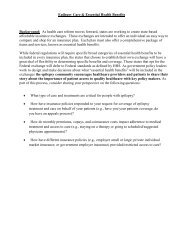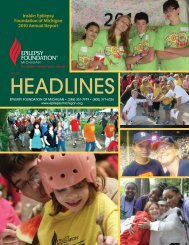Legal Rights of Children with Epilepsy in School & Child Care
Legal Rights of Children with Epilepsy in School & Child Care
Legal Rights of Children with Epilepsy in School & Child Care
Create successful ePaper yourself
Turn your PDF publications into a flip-book with our unique Google optimized e-Paper software.
Seizure Action Plan<br />
Effective Date<br />
This student is be<strong>in</strong>g treated for a seizure disorder. The <strong>in</strong>formation below should assist you if a seizure occurs dur<strong>in</strong>g<br />
school hours.<br />
Student’s Name<br />
Date <strong>of</strong> Birth<br />
Parent/Guardian Phone Cell<br />
Other Emergency Contact Phone Cell<br />
Treat<strong>in</strong>g Physician<br />
Phone<br />
Significant Medical History<br />
Seizure Information<br />
Seizure Type Length Frequency Description<br />
Seizure triggers or warn<strong>in</strong>g signs:<br />
Student’s response after a seizure:<br />
Basic First Aid: <strong>Care</strong> & Comfort<br />
Please describe basic first aid procedures:<br />
Does student need to leave the classroom after a seizure? ❒ Yes ❒ No<br />
If YES, describe process for return<strong>in</strong>g student to classroom:<br />
Emergency Response<br />
A “seizure emergency” for<br />
this student is def<strong>in</strong>ed as:<br />
Seizure Emergency Protocol<br />
(Check all that apply and clarify below)<br />
❒ Contact school nurse at __________________________<br />
❒ Call 911 for transport to __________________________<br />
❒ Notify parent or emergency contact<br />
❒ Adm<strong>in</strong>ister emergency medications as <strong>in</strong>dicated below<br />
❒ Notify doctor<br />
❒ Other ________________________________________<br />
Treatment Protocol Dur<strong>in</strong>g <strong>School</strong> Hours (<strong>in</strong>clude daily and emergency medications)<br />
Basic Seizure First Aid<br />
• Stay calm & track time<br />
• Keep child safe<br />
• Do not restra<strong>in</strong><br />
• Do not put anyth<strong>in</strong>g <strong>in</strong> mouth<br />
• Stay <strong>with</strong> child until fully conscious<br />
• Record seizure <strong>in</strong> log<br />
For tonic-clonic seizure:<br />
• Protect head<br />
• Keep airway open/watch breath<strong>in</strong>g<br />
• Turn child on side<br />
A seizure is generally<br />
considered an emergency when:<br />
• Convulsive (tonic-clonic) seizure lasts<br />
longer than 5 m<strong>in</strong>utes<br />
• Student has repeated seizures <strong>with</strong>out<br />
rega<strong>in</strong><strong>in</strong>g consciousness<br />
• Student is <strong>in</strong>jured or has diabetes<br />
• Student has a first-time seizure<br />
• Student has breath<strong>in</strong>g difficulties<br />
• Student has a seizure <strong>in</strong> water<br />
Emerg.<br />
Dosage &<br />
Med. ✓ Medication Time <strong>of</strong> Day Given Common Side Effects & Special Instructions<br />
Does student have a Vagus Nerve Stimulator? ❒ Yes ❒ No If YES, describe magnet use:<br />
Special Considerations and Precautions (regard<strong>in</strong>g school activities, sports, trips, etc.)<br />
Describe any special considerations or precautions:<br />
Physician Signature ___________________________________________________ Date _________________________________<br />
Parent/Guardian Signature _____________________________________________ Date _________________________________<br />
DPC772








